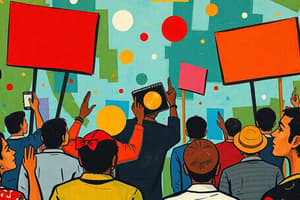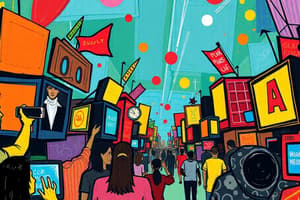Podcast
Questions and Answers
What characterizes highbrow culture?
What characterizes highbrow culture?
- Easy and light-hearted content suitable for all ages
- Cultural products considered sophisticated or intellectually challenging (correct)
- Entertainment aimed at a mass audience
- Visual storytelling mediums like comic books
Which of the following best describes middlebrow culture?
Which of the following best describes middlebrow culture?
- Cultural products that are sophisticated and elite
- Cultural products that are seen as overly simplistic
- Entertainment that is exclusively for intellectual audiences
- Products appealing to a middle-class audience falling between high-brow and low-brow (correct)
Which group typically appreciates lowbrow mass media?
Which group typically appreciates lowbrow mass media?
- Cultural consumers with sophisticated tastes
- Those wanting to escape from daily routine (correct)
- People who can distinguish good from bad films
- Individuals looking for intellectual engagement
Soaps, sitcoms, and comics are categorized under which type of culture?
Soaps, sitcoms, and comics are categorized under which type of culture?
Which term is synonymous with someone who claims superiority in culture and intellect?
Which term is synonymous with someone who claims superiority in culture and intellect?
Flashcards are hidden until you start studying
Study Notes
Popular Culture
- Popular culture consists of cultural products, activities, and entertainment widely accessible and enjoyed by the public.
- Soaps (soap operas), sitcoms (situation comedies), and comics are examples of popular culture.
- These forms of entertainment are consumed by a large and diverse audience.
Highbrow, Middlebrow & Lowbrow Culture
- Highbrow culture is associated with sophisticated or intellectually challenging products, often linked to high art or elite audiences.
- Middlebrow culture falls between highbrow and lowbrow, targeting a middle-class audience.
- Lowbrow mass media appeals to those seeking to escape daily routine.
Mass Media and Audience
- People who appreciate lowbrow mass media seek entertainment and escapism.
- Those who value middlebrow mass media are sophisticated, understand the medium, and seek intellectual satisfaction.
- Appreciation of highbrow mass media indicates the ability to distinguish between good and bad content.
Synonym of "Superior in Culture and Intellect"
- Highbrow, elite, patrician, and noble are synonyms for someone claiming to be superior in culture and intellect.
- Patrician refers to an aristocrat.
- Highbrow describes intellectual or refined taste.
- Elite denotes a select group with superior abilities or qualities.
- Noble refers to someone of aristocratic rank or birth.
Outdoor Media
- Outdoor Media or Out of Home Media transmits information and news to the public when they are outside their homes.
- It informs about new products, social information, and advertisements.
- Forms include signs, placards, posters, banners, and wallspace.
Transit Media
- Transit Media focuses on advertising to audiences while they are on the move, such as public transportation.
- Advertisements are displayed on buses, taxis, and trains for brand promotion.
New Media (Digital Media)
- The Internet and World Wide Web have revolutionized mass communication with mediums such as email, websites, podcasts, e-books, blogging, social networking sites, IPTV, and internet radio.
- New media encompasses these digital means of producing, transmitting, and receiving messages.
- Digital media is a two-way communication platform allowing users to actively produce content and consume information.
- Digital media can be text, audio, graphics, and video.
- Examples include: emails, websites, social media, blogging, e-forums, e-books, IPTV, digital videos, virtual reality, webcasts, podcasts, and internet radio.
Responsibilities of Mass Media
- Mass media plays a crucial role in fostering democracy, plurality, and communal harmony through:
- Information and Education
- Socialization
- Entertainment
- Political awareness
- Cultural transmission
- Catalyst to development
Objectives of Mass Media
- The primary objectives of mass media are:
- Information
- Education
- Entertainment
- Persuasion
Culture and Mass Media
- Culture encompasses beliefs, customs, values, behaviors, and artifacts shared by a group of people.
- Culture influences people's way of life and shapes their identity.
Mass Communication
- Mass media reaches a large, scattered, heterogeneous, and anonymous audience simultaneously.
- It has been a boon to human society.
- Mass media communication can be written, spoken, or broadcast.
- Examples include newspapers, magazines, radio, advertisements, social media, television, internet, and films.
Traditional Media
- Traditional media are older forms of media that transmit culture and tradition across generations.
- They have evolved from customs, rituals, beliefs, and practices of society.
- Examples include:
- Folk arts and music
- Theatres and drama
- Fairs and festivals
Print Media
- Print media conveys information in print format to a large audience.
- Examples include:
- Newspapers
- Magazines, periodicals, and journals
- Books, novels, and comics
Electronic Broadcasting Media
- Electronic broadcasting media utilize audio and visuals for content distribution.
- It provides news and information to a wide audience, including those who are illiterate or have hearing or sight impairments.
- Examples include:
- Film
- Television
- Radio
History of Electronic Media in India
- The first radio station in India was established in Bombay in 1923 by the Radio Club of Bombay.
- The Indian Broadcasting Company (IBC) was formed in 1927 and started regular broadcasts in 1930.
- In 1936, the IBC was nationalized and renamed All India Radio (AIR).
- Television was introduced in India in 1959 with an experimental station in Delhi.
- Regular television broadcasts began in 1965, and Doordarshan, the national broadcaster, was established in 1975.
Studying That Suits You
Use AI to generate personalized quizzes and flashcards to suit your learning preferences.




